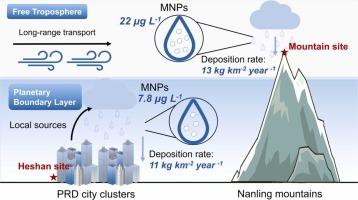在对流层自由运输的驱动下,偏远山区微纳米塑料的湿沉积升高
IF 11.3
1区 环境科学与生态学
Q1 ENGINEERING, ENVIRONMENTAL
引用次数: 0
摘要
空气中的微和纳米塑料(MNPs)可以到达自由对流层(FT)并运输到偏远地区,然而,它们在FT中的湿沉积尚不清楚。在这里,我们研究了中国南方一个偏远山区保护区的高海拔地点(海拔1700米)的MNP湿沉积,并将其与受城市外流影响的低海拔地点(海拔60米)进行了比较。MNPs通过热解-气相色谱-质谱(Pyr - GC/MS)进行鉴定和定量,通过外部校准到质量浓度,从诊断的热解产物中分离出聚合物类型。山区雨水MNP事件平均浓度平均为22.0±20.5 μg L-1,比低空站点(7.8±4.3 μg L-1)高近3倍,表明青藏高原存在大量MNP负荷。反轨迹分析表明,主要来源是来自珠江三角洲的区域输送和来自印度支那半岛的远程输送。季节模式显示,春季以降雨扫食为主,而夏季以风力驱动的FT运输为主。山地保护区MNP湿沉降平均为54 μg m-2 event-1(事件-平均浓度×降雨深度),年速率为13 kg km-2,年总量为7.4公吨。我们的研究结果表明,FT既是空气中MNPs的运输途径,也是临时储存库,突出了其在大气塑料全球命运中的作用。本文章由计算机程序翻译,如有差异,请以英文原文为准。

Elevated Wet Deposition of Micro- and Nano-plastics in Remote Mountains Driven by Free Tropospheric Transport
Airborne Micro- and nano-plastics (MNPs) can reach the free troposphere (FT) and transport to remote regions, however, their wet deposition within FT remains unclear. Here, we investigated MNP wet deposition at a high-elevation site within the FT (1700 m a.s.l.) in a remote mountain reserve in southern China, and compared it with a low-altitude site (60 m a.s.l.) influenced by urban outflow. MNPs were identified and quantified by pyrolysis–gas chromatography–mass spectrometry (Pyr−GC/MS), resolving polymer types from diagnostic pyrolysates with external calibration to mass concentrations. Event-mean MNP concentrations in mountain rainwater averaged 22.0 ± 20.5 μg L-1, nearly three times higher than at the low-altitude site (7.8 ± 4.3 μg L-1), suggesting substantial MNP loads in the FT. Back-trajectory analysis identified dominant sources as regional transport from the Pearl River Delta and long-range transport from the Indochina Peninsula. Seasonal patterns showed that rainfall scavenging dominated in spring, while wind-driven FT transport prevailed in summer. MNP wet deposition averaged 54 μg m-2 event-1 (event-mean concentration × rainfall depth), with an annual rate of 13 kg km-2, totaling 7.4 metric tons per year in the mountain reserve. Our results indicate that the FT acts as both a transport pathway and a temporary reservoir for airborne MNPs, highlighting its role in the global fate of atmospheric plastic.
求助全文
通过发布文献求助,成功后即可免费获取论文全文。
去求助
来源期刊

Journal of Hazardous Materials
工程技术-工程:环境
CiteScore
25.40
自引率
5.90%
发文量
3059
审稿时长
58 days
期刊介绍:
The Journal of Hazardous Materials serves as a global platform for promoting cutting-edge research in the field of Environmental Science and Engineering. Our publication features a wide range of articles, including full-length research papers, review articles, and perspectives, with the aim of enhancing our understanding of the dangers and risks associated with various materials concerning public health and the environment. It is important to note that the term "environmental contaminants" refers specifically to substances that pose hazardous effects through contamination, while excluding those that do not have such impacts on the environment or human health. Moreover, we emphasize the distinction between wastes and hazardous materials in order to provide further clarity on the scope of the journal. We have a keen interest in exploring specific compounds and microbial agents that have adverse effects on the environment.
 求助内容:
求助内容: 应助结果提醒方式:
应助结果提醒方式:


